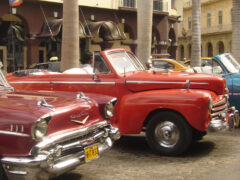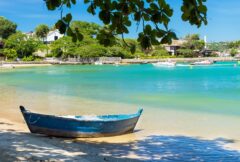The old man and the Séat

Alberto Korda. A name familiar to few, but whose most famous piece of work has been seen by millions. You may have seen it on a t-shirt, on a souvenir mug or on a poster adorning the wall of some student digs. Those eyes staring into the middle distance, the single-star crested beret and the thin whiskers.
Fifty years ago, Alberto Korda captured the iconic image of Che Guevara that came to symbolise a new chapter in Cuba’s history. That chapter, half a century later, is nearing an end and the future of Cuba is difficult to predict.
This uncertainty is inspiring many travellers to visit the island “before it changes”. Time will tell what these changes will mean for the people of the island, and their families living abroad, but it is likely that this tropical Communist time-bubble is soon to pop.
With all this in mind, I suggested to my father that we really should seize the opportunity to explore Cuba and we should do so, sotto voce, by car. The first part of the suggestion registered delight on the face of this academic lefty. However, the second part of the sentence elicited a look of quiet resignation – for my father knows perfectly well that I cannot drive.
And, lo, he found himself pulling out of the car rental offices and driving westbound along Havana’s malecón. Past the strolling couples dodging the cascading sea spray, past the rusting but beautiful cadillacs and through the affluent suburbs. And straight past the turn-off for the supermarket that was ear-marked for picnic supplies. This was the first sign, or not as the case may be, that I was going to need to pay extra attention when navigating our way around Cuba.
At this stage however, the route we needed to take was relatively easy. As long as I could see the Caribbean on my right then we were on course.
The first place of interest that we came to was Mariel. This exceptionally ugly town boasts the island’s largest cement factory and a thermal electricity plant – not a place that features on many Journey Latin America itineraries. The joy of independent travel, however, is that you stumble upon these little places that have a history that far outweighs their current status. For it was from here over a few months in 1980 that some 125,000 Cubans embarked for Miami during what became known as the Mariel Boatlift.
Our aim for the first night was Las Terrazas and a stay at the La Moka hotel. This small town (or large village) sprung up in 1971 as a forestry and soil conservation centre within the Biosphere Reserve. Today the area offers wonderful walking opportunities, good food from the lake-side restaurant and natural pools in which to relax after your first day on the Cuban roads.
The second day began with breakfast at the hotel restaurant. It was difficult to pull ourselves away from the views out over the forest, but we had a long drive ahead of us and an early start was essential.
The drive, after negotiating the ring road of Havana, could not have been easier. The motorway that ran down towards Cienfuegos, our next stop, resembled an extended airport runway that stretched out towards the horizon. Once again, navigation was simple (“Straight on, for five hours!”) as we drove past field after field after field. Lunch was taken at a small service station, whose ham and cheese bap offered the same culinary experience that one expects from service stations the world over – Michelin tyres everywhere (some burning), but not a star to be seen.
Arriving at the pre-arranged casa particular in Cienfuegos, we had just enough time to eat our wonderfully prepared dinner before popping over to the yacht club for a sundown beer. Boats bobbed in the ocean as the sunset lit the sky with colourful rays – for the tourist, the harder life of the islanders can seem disconcertingly far away.
The next morning ushered in more sunshine and an hour’s drive to Trinidad. We had planned to spend three nights around this UNESCO World Heritage site, the nearby white-sand beaches and the surrounding countryside. The first test of the day, however, was to negotiate the atmospheric streets of eighteenth and nineteenth-century buildings in varying states of crumbling splendour. The second test, slightly more stressful, was to manoeuvre the large car into the garage of our casa particular. Once the latter was completed we soaked up the colonial ambiance of this beautiful town, the distinctive sounds of local music and an undisclosed number of cuba libres.
Trinidad offers some of the best opportunities to enjoy a range of Cuban music and the restaurants here are of a good standard. They can be found, eventually, tucked away in the hidden gardens of pretty colonial mansions.
Furthermore, having a car affords you the opportunity to explore the places that are usually a little trickier to visit. These places abound near Trinidad; the “locals’” beach of La Boca, the birdlife of the surrounding forested hills and several interesting historical sites, such as the Torre de Manaca Iznaga. The torre (tower) was originally built to keep watch on the slaves working in the surrounding sugar mills. Today, the tourist attraction allows you unobstructed views of the countryside from its 43.5m-high lookout.
All of these places can be found by employing good map skills or, even easier, by picking up one of the friendly locals who wait by the side of the road for lifts. By doing this, you are not only playing the Good Samaritan but you’ll also get directed towards your destination and perhaps learn some local history en route. This route may have slight detours, such as past the house of your passenger’s cousin, but you will get there eventually!
Dropping the car off in Havana, I thought back over the previous few days. It is true that for driving in Cuba you will require a little more patience, some directional confidence and, in my case, a father willing to do all the driving - thanks, Dad. But you will leave the country richer for your experiences; those little villages that the buses would have avoided, the hidden Caribbean coves and the wide ranging conversations that you can have with the locals as you cruise down the motorway. Best get there “before it changes”.
Kitt Collins; former Journey Latin America staffer
Tailor-made holidays
Flexible, custom-made holidays to Latin America created to match your exact requirements: our tailor-made itineraries are as unique as the clients for whom they are designed.
Design my tripPapagaio
Your edit for Latin American inspiration
Our exciting range of articles on Latin America explore everything from iconic destinations and lesser-known cultural gems to delicious traditional recipes. You’ll also find exclusive travel tips, first-hand client reviews and the chance to get your personal questions answered by our travel experts.
View Extraordinary Inspiration






































